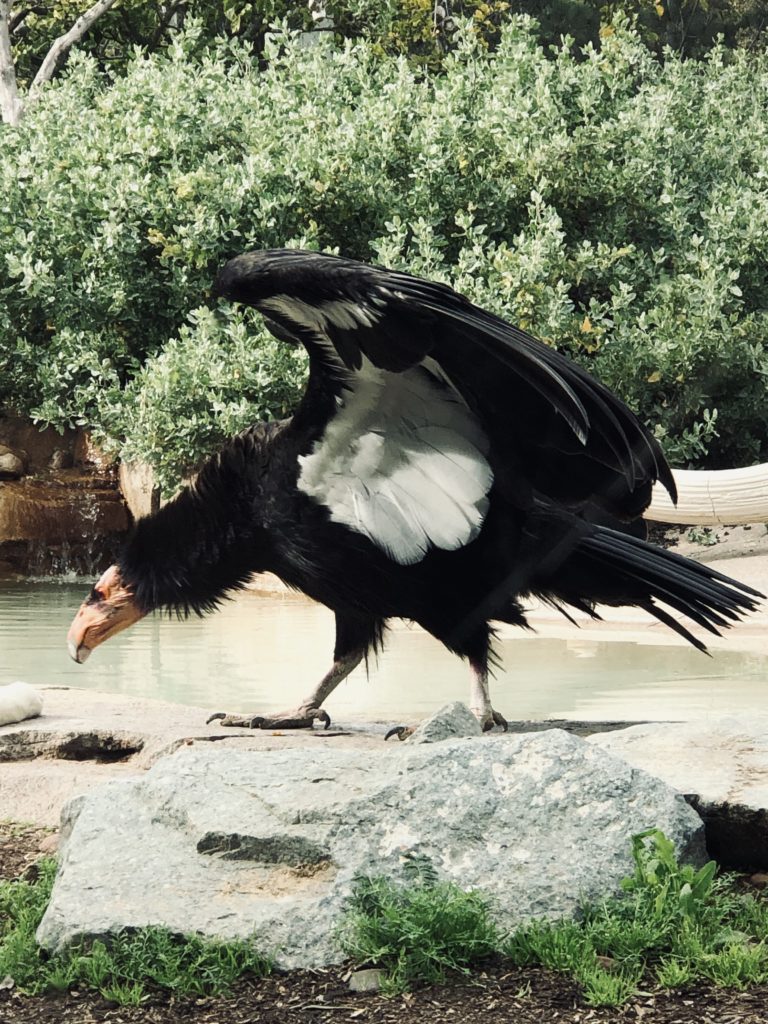Zoo Internquest is a seven-week career exploration program for San Diego County high school juniors and seniors. Students have the unique opportunity to meet professionals working for the San Diego Zoo, Safari Park, and Institute for Conservation Research, learn more about their jobs, and then blog about their experience online. Follow their adventures here on the Zoo’s website!

The San Diego Zoo makes it a priority to start and support many different conservation efforts around the world that protect and preserve thousands of animals from extinction. One of these conservation projects is even taking place in our own backyard! This week, my fellow interns and I were honored to meet with Amanda Wert who is a Keeper at the San Diego Zoo. Ms. Wert specializes in caring for the breathtaking California condor which is the largest native bird residing in North America. From feeding these amazing birds, to cleaning and maintaining their enclosure, Ms.Wert works hard every day to ensure that these birds are both happy and healthy during their time at the Zoo. Ms. Wert, however, refrains from forming any relationship with the California condors because many of them may be candidates for re release into the wild in an attempt to save their dwindling populations.
Ms. Wert attended Silliman University in the Philippines where she earned a bachelor’s degree in general biology and has been working at the San Diego Zoo as a bird keeper for around six years. Ms. Wert is currently caring for two male California condors at the Zoo that were born in 2008 and 2011 and have already reached full maturity. When full grown, a California condor can weigh around 20 pounds, live for as long as 60 years, and have a wingspan as large as nine and a half feet! Condors are scavenger birds and prefer to eat large dead animals like deer, cattle and sheep in the wild. At the Zoo however, the California condors feast on rabbits, rats, mice, trout, herring, and even cow spleen! While working with these amazing birds, Ms. Wert said that her main goal is to make the lives of the California condors at the Zoo better as well as learn more about them and their wild counterparts.
Throughout the past couple of decades, the California condor has faced many threats that have taken their toll on the wild populations as well as pushed the entire species to the brink of extinction. In 1987, the California condor was declared extinct in the wild when the 22 remaining California condors were gathered up and placed in a laboratory to promote breeding and save the species from complete extinction. There were many different factors that played a role in dramatically reducing California condor populations throughout the southwest United States and Baja California. The most significant threat was the use of lead bullets that hunters in the area would use to hunt other animals. Lead ammunition accounted for close to half of all California condor deaths in 1992 and continues to be a problem until a law is passed banning the use of lead ammunition. These bullets would be left in the carcasses of animals which would then be eaten by California condors who would then die of heavy metal poisoning. Other threats include very low reproductive rates, microplastics, and the bioaccumulation of pesticides such as DDT. DDT causes the eggs of the California condor to become brittle and break while the mother incubates them.
While the Zoo is releasing California condors back into the wild to try and re-establish their natural populations, this proves to be a very difficult and lengthy process. California condors naturally only have a single egg every two years. Given their slow reproductive rate, the recovery of the California condor population will take many years considering that only ten wild chicks were born in the year 2016. However, the San Diego Zoo has saved the California condor from almost certain extinction with the help of an SSP or Species Survival Plan. By dictating the breeding of different California condors, their SSP has worked with the Zoo to increase California condor numbers to 290 birds in the wild; 170 of which are living in California. The San Diego Zoo to this day continues to support the conservation of California condors in hopes of restoring them to their once stable and natural levels.
With the help of keepers like Ms. Wert, the San Diego Zoo is able to preserve thousands of species of animals from the threat of extinction. Ms. Wert shared that even you at home can support California condor conservation efforts by being mindful of litter as well as avoiding the use of lead ammunition. Together we can help the Zoo work to preserve this amazing species in hopes of removing it from the critically endangered list. Please continue to read the blog posts that my fellow interns and I post each week to continue alongside us on this amazing and unforgettable journey!
Cole, Conservation Team
Week Five, Winter Session 2019


